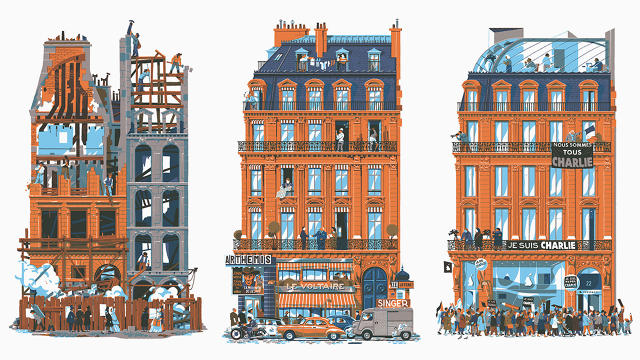750 Years Of Parisian History, As Told Through Architectural Illustrations
750 Years in Paris by Vincent Mahé is a visual time machine.
“I’ve always been fascinated by cities—especially cities that have a long history like mine,” Paris-based illustrator Vincent Mahé says. Since its founding in 3 B.C., the City of Light has experienced astronomical highs (like hosting the World Cup in 1998 when France won) and devastating lows (like, oh say, Nazi occupation during WWII). Architecturally speaking, there are countless landmarks that have cemented Paris’s standing as one of the most beautiful cities—the Arc de Triomphe, Charles Garnier’s opera house, Haussmann’s grand boulevards. But for 750 Years in Paris, a forthcoming book from Nobrow Press, Mahé turns his focus on a single block in the city and charts its changes through the years, starting in 1265 and culminating in 2015.

Mahé came up with the book’s concept while he was walking through the city. “Generations have lived here before us, they’ve walked on this very same pavement, they’ve been under that same sky,” he says. “They left us buildings, like testimonies from the past. That game me the idea to make a time machine out of it.”
To Mahé, architecture offers a compelling narrative, especially considering that Paris has pretty stringent conservation laws. “Buildings tell everything in cities,” he says. “From the oldest building from the middle ages renovated many times to the contemporary museum built two years ago, they’re like glass, wood, and stone giants that can live for 500 years. During this ‘life’ they can show wealth and poverty, war times and peace.”
After snapping photographs of the oldest buildings in the heart of Paris, researching museum collections (Musée Carnavalet in Le Marais was the best), and pouring over history books, Mahé began outlining the book. Rather than using words, he relies on imagery to tell the story.
The building begins in 1265 as a stone structure in a pastoral setting. Page by page, the building evolves and grows in size. Attentive readers will take note of the skeleton piles in 1348, which symbolize when the Black Plague decimated the city’s population. The parade of axe-wielding people in the illustration for 1789 represents none other than the Storming of the Bastille during the French Revolution. 1853 shows construction taking place as Haussmann begins to standardize the city’s architecture. Mahé emblazons the building with swastikas and German-language signage in 1943 to represent the occupation. Rabid soccer fans take to the street in 1998 and in 2015, the masses are protesting the Charlie Hebdo massacre.
“I started the book in 2013, before the event of Charlie Hebdo,” Mahé says. “The book wasn’t supposed to end like this originally, but this was Paris’s history going on right before us. It had to be in there.”
Scenes of everyday life provide pacing between the historic events, and each page is lovingly illustrated.
“By the way, why not start reading the book from the end?” Mahé suggests. “‘Back from the future’ style.”
All history books should be as visually rich. How about 750 years in New York City next?
Fast Company , Read Full Story
(71)



